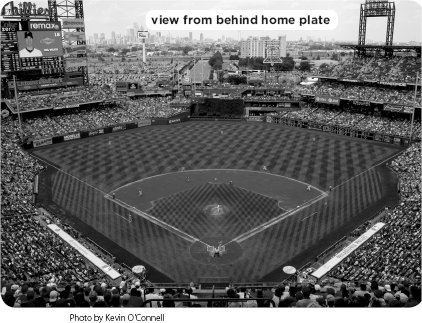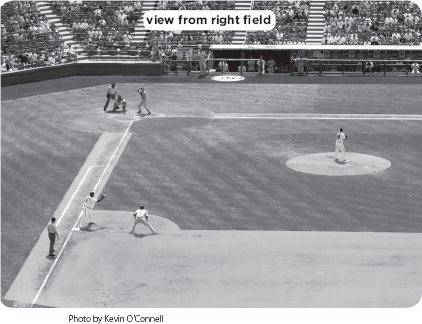Ultimate Baseball Road Trip (24 page)
Read Ultimate Baseball Road Trip Online
Authors: Josh Pahigian,Kevin O’Connell

These home run territory second-deck seats in left field are a solid option. And if you’re planning to visit Harry the K’s,
they’re even more attractive, as you will get a discount on your food. Not enough to make up for the long lines and mediocre food at Harry’s, but for some people it’s all about getting the discount. Sight lines lost in these sections are equivalent to about double the warning track in left field, so not too bad, because you still feel close to the action.


The seating area is named after Harry Kalas, of course, who was a Phillies broadcaster from 1971 through 2009. Mr. Kalas was a legend in his own time, and the entire city of Philadelphia wept when he collapsed in the Nationals Park press box and died in April 2009.
These are the upper deck seats located below the midlevel concourse. In most parks, they’re called Upper Boxes. We recommend avoiding the distant sections in left field, but otherwise these are fantastic for upper level seats with very well-protected sight lines and almost no underhang issues at all until you get out to 330 and 331, which lose the left-field corner, but not too much. Sections 332 and 333 should be avoided entirely because the loss of the corner becomes more significant.
Sections 309 and 310 just beyond first base provide decent enough bird’s-eye views of the infield. Sections 301 to 304 in right-field home run territory (as if a ball is ever going to be hit up here) provide a straight-on view of the field, but Sections 305, 306, and 307 have foul-pole obstructions.
Located on the third deck, above the midlevel concourse, the Terrace Deck feels right on top of the game. Compared to the rest of the baseball universe, these sections hold up well. The roof provides more shelter from the sun than you might expect and the views into downtown Philly are great. Aim for Sections 414 to 426 to have a quality view of the infield. Don’t settle for the cheap seats out in left field (Sections 430 to 434) unless you’re really hard up.
At Connie Mack Stadium folks on 20th Street enjoyed free views of the game from their own rooftops. The Phillies have attempted to duplicate the effect with two sections of bleachers atop Ashburn Alley’s outfield entertainment area beneath the towering neon Liberty Bell. Although these seats are miles from the action, and suffer from serious side-hang obstruction issues from the middle deck of the upper structure that come across and block views of first base, they do embrace a feature of the old park that fans
found special. Plus, there’s something fun about sitting in the peanut gallery every once in a while, even if the light poles in Ashburn Alley block views as well. Sitting toward the centerfield part of the section is more advisable, and as always, you don’t have to stay if your seats aren’t any good. On hot days, there’s a misting fan behind the bleachers that provides a much-needed way for fans to beat the Philly heat.

SEATING TIP
For thrifty readers, the tickets to get are the Standing Room Only ones, which go on sale before each game. They sell out quickly, as they are among the cheapest in the ballpark. And don’t worry about finding a place to set up shop. Though seat-hopping is tough at CBP, with these tickets you can access the entire ballpark (except the club level), and by arriving early you can easily stake out your spot along the Standing Room railings lining the tops of all seating areas, the100 level included. When we say railings, it’s for lack of a better term, because these function more like bar tops, where you are encouraged to set down food and drink and stay as long as you like. The concourses are as wide as they come in the majors, so you won’t feel as if you’re getting edged out of your spot by the people behind you walking around. Again, these railings go fast, so get there early. If the standing room tickets are gone when you’re buying your way inside, just get the cheapest 300-level ticket you can find, and do the same thing.
Josh:
Building a fan and shooting water through it?
Kevin:
Brilliant!
Mill around in the parking lot for a few minutes and the scalpers will come to you. This is the East Coast, so expect to be locking horns with some pretty tough cookies. The town may call itself a City of Brotherly Love, but the street-hardened scalpers will rake you over the coals if you let them, so be careful. Check your ticket dates and section numbers, then double-check before finalizing any sale.
Out of necessity, the Phillies’ ballpark has become a destination unto itself, complete with pregame historic attractions and drinking establishments within the gates. This makes sense, since there isn’t much to do or see in the immediate vicinity of the ballpark. If you’re driving to the game, we recommend arriving at the Sports Complex early to beat the traffic, get a choice parking space, and take in some of the pregame activities the Phillies have pre-planned for fans.
If you’re arriving in town earlier in the day, we recommend making your way to South Street, which offers unique Philly foods, a nice choice of restaurants, and a bit of the historic feel one might expect when visiting Philadelphia. When you’re ready to leave for the stadium, it’s just a five-minute drive.
After the game, we recommend putting your wallet in your front pants pocket and making the daring pilgrimage into South Philly for a late-night cheesesteak. As Josh put it upon finishing his third steak, “If I’ve placed my life in danger, it was worth every bite.”
The best thing about building a ballpark in a sports complex is that it’s easy to get to and there’s plenty of parking. And thanks to this complex’s location at the intersection of two major highways, traffic isn’t too bad before or after games. From Interstate 95, take Exit 17 (Broad Street), which leads right into the stadium lot. From Interstate 76, take Exit 349 (Sports Complex).
Either pay the cash to park at the complex lots or pass the complex and try to locate a free spot in South Philly. We took a left on Packer Street and followed it a block under the highway overpass to arrive at a wealth of streets on the left that led into a residential neighborhood where plenty of free street parking awaited. The neighborhood looks safe and parking there doesn’t require a resident sticker. This parking was close to the Vet, but is more than a few blocks from the new park. It is, however, close to the Philadium Tavern (see below), a must-visit before the game.
For fans interested in banging around town on foot, then heading to the game, the SEPTA Broad Street Subway is accessible from the South Philly, North Philly, and Center City subway stations. Take the Broad Street train, southbound, to the last stop (Pattison Avenue).
Staying at the nearby Holiday Inn Stadium seemed like a good idea to us at first, but unless you’re just looking for a convenient place to crash after the game, we don’t recommend it, because there isn’t much else to do in the neighborhood—have we stressed that enough now?
PHILLY LIVE
Philly Live was originally planned to be more than 300,000 square feet of entertainment space on the site of the old Spectrum, but a flagging economy has forced developers to build it in stages, the first of which was a fifty thousand-square-foot sports bar, dubbed the largest in the country. Still, if the Phils were determined to build at SPSC (South Philly Sports Complex), then Philly Live is a smart way to develop the area.
Eventually, more bars are planned, as well as restaurants, shops, a hotel, and even an outdoor music venue. All of these will improve the pregame and postgame options at the SPSC. The planners have designed the venue to bring people in year-round, but the driving factor is that there will be visitors to one of the sports venues more than three hundred days out of the year. Though it’s a bit like a mall in many aspects, we applaud the effort, even if it had just started at the time of our most recent visit. Keep building, Philly Live.
The Phillies commissioned a bevy of new statues for their ballpark, but the old bronzes still stand at the corners, outlying the four entrances to The Vet. It’s a considerable walk
on a hot August day, especially if you’re planning on encircling the new ballpark to view the new statues erected, but hey, some folks are true Philly phans, so who are we to dissuade them? Two of the Vet statues depict generic baseball players, while two represent athletes who played the other sport played at the venue (football). Hardcore Philly phans can seek out the Vet’s old home plate, which is set in concrete.
Kevin:
Pitch one to me.
Josh:
Why not? The concrete isn’t that much worse than the old turf used to be.
Three statues adorn the outside of the new ballpark. All three pay homage to the city’s baseball heritage, if not that of the Phillies themselves.
Though he played for six teams during an illustrious career, Philly claims this southpaw as its own, and rightfully so. The statue honoring Carlton stands outside the Left Field Gate, hurling a certain strike as he lunges forward extending toward the plate. The statue itself captures a strong likeness to Carlton’s throwing style, but the face is a bit off. We’re not blaming the sculptor, Zenos Frudakis, it’s just that it has always been difficult to capture ’70s facial hair in bronze, and the look on Carlton’s face is a bit funky. Carlton’s career numbers are undeniably top-notch, as he won four Cy Young Awards, was a ten-time All Star, picked 144 runners off base, and posted a lifetime ERA of 3.22 over 24 seasons. He was a first-ballot Hall of Famer in 1994.
A Three-Way Gun Fight
Toward the end of his career, Carlton battled Nolan Ryan and Gaylord Perry in a race to break Walter Johnson’s all-time strikeout record. Johnson had held the mark for fifty-five years at the beginning of the 1982 season, but Carlton, Ryan, and Perry were all within striking distance. Ryan got there first, but Carlton surpassed him after Ryan landed on the DL. Perry broke Johnson’s record as well, though he was closer to the tail end of his career and was not going to factor in long term. The lead for most strikeouts passed back and forth between Carlton and Ryan multiple times until 1984, when Ryan took control of the record for good, ending up with 5,714 to Carlton’s 4,136. Later, Randy Johnson (4,875) and Roger Clemens (4,672) would surpass Carlton’s total.
The Third Base Gate could only belong to one Philly, the incomparable Mike Schmidt. Accordingly, a statue there bears the likeness of the man many believe to be the greatest player ever at the hot corner. Schmidt’s laurels include three National League MVP awards, ten Gold Gloves, twelve All-Star nods, 548 career home runs (he led the NL eight times), and a career fielding percentage of .961. The Hall of Famer played his entire career for the Phillies, and holds almost all of the team’s most important offensive and defensive records.